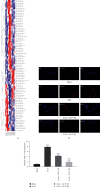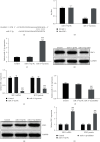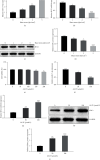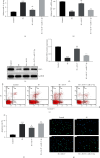Astragaloside IV Protects against Shear Stress-Induced Glycocalyx Damage and Alleviates Abdominal Aortic Aneurysm by Regulating miR-17-3p/Syndecan-1
- PMID: 39290461
- PMCID: PMC11407896
- DOI: 10.1155/2024/2348336
Astragaloside IV Protects against Shear Stress-Induced Glycocalyx Damage and Alleviates Abdominal Aortic Aneurysm by Regulating miR-17-3p/Syndecan-1
Abstract
Background: The present study aimed to analyze the impact of astragaloside IV (AS-IV) on abdominal aortic aneurysm (AAA) and the glycocalyx, elucidating the potential mechanism of AS-IV.
Methods: Rat models of AAA were established using porcine pancreatic elastase. The effects of intraperitoneal AS-IV injection on the morphology, diameter, and glycocalyx of the aorta and the expression of miR-17-3p and Syndecan-1 (SDC1) protein were examined. Differentially expressed miRNAs from peripheral blood samples of healthy individuals, untreated patients with AAA, and treated patients with AAA were identified through sequencing. The relationship between miR-17-3p and SDC1 was validated using a dual-luciferase reporter assay. In vitro, shear stress was induced in human aortic endothelial cells (HAECs) to simulate AAA. Overexpression of miR-17-3p was performed to assess the effects of AS-IV on miR-17-3p and SDC1 expressions, apoptosis, and glycocalyx in HAECs.
Results: AS-IV mitigated aortic damage in AAA rats, reducing the aortic diameter and alleviating glycocalyx damage. In addition, it suppressed the increase in miR-17-3p expression and promoted SDC1 expression in AAA rats. Peripheral blood miR-17-3p levels were significantly higher in patients with AAA than in healthy individuals. miR-17-3p inhibited the SDC1 protein expression in HAECs. In the in vitro AAA environment, miR-17-3p was upregulated and SDC1 was downregulated in HAECs. AS-IV inhibited miR-17-3p expression, promoted SDC1 expression, and mitigated shear stress-induced apoptosis and glycocalyx damage in HAECs. Overexpression of miR-17-3p blocked AS-IV-induced SDC1 expression promotion, glycocalyx protection, and apoptosis suppression in HAECs.
Conclusion: miR-17-3p may damage the glycocalyx of aortic endothelial cells by targeting SDC1. AS-IV may promote SDC1 expression by inhibiting miR-17-3p, thereby protecting the glycocalyx and alleviating AAA.
Copyright © 2024 Guojian Li et al.
Conflict of interest statement
The authors declare that they have no competing interests.
Figures






Similar articles
-
MiR-222-3p downregulation prompted the migration, invasion and recruitment of endothelial progenitor cells via ADIPOR1 expression increase-induced AMKP activation.Microvasc Res. 2021 May;135:104134. doi: 10.1016/j.mvr.2021.104134. Epub 2021 Jan 9. Microvasc Res. 2021. PMID: 33428882
-
miR-19a-3p affected ox-LDL-induced SDC-1/TGF-β1/Smad3 pathway in atherosclerosis.Cell Mol Biol (Noisy-le-grand). 2023 Mar 31;69(3):75-81. doi: 10.14715/cmb/2023.69.3.10. Cell Mol Biol (Noisy-le-grand). 2023. PMID: 37300685
-
Potency of miR-144-3p in promoting abdominal aortic aneurysm progression in mice correlates with apoptosis of smooth muscle cells.Vascul Pharmacol. 2022 Feb;142:106901. doi: 10.1016/j.vph.2021.106901. Epub 2021 Aug 6. Vascul Pharmacol. 2022. PMID: 34364983
-
The potential involvement of glycocalyx disruption in abdominal aortic aneurysm pathogenesis.Cardiovasc Pathol. 2024 May-Jun;70:107629. doi: 10.1016/j.carpath.2024.107629. Epub 2024 Mar 9. Cardiovasc Pathol. 2024. PMID: 38461960 Review.
-
Glycocalyx damage biomarkers in healthy controls, abdominal surgery, and sepsis: a scoping review.Biomarkers. 2020 Sep;25(6):425-435. doi: 10.1080/1354750X.2020.1787518. Epub 2020 Jul 4. Biomarkers. 2020. PMID: 32597227
Cited by
-
Transport across the thoracic aortic wall: implications for aneurysm pathobiology, diagnosis, and treatment.Am J Physiol Heart Circ Physiol. 2025 May 1;328(5):H1113-H1129. doi: 10.1152/ajpheart.00886.2024. Epub 2025 Apr 7. Am J Physiol Heart Circ Physiol. 2025. PMID: 40192071 Free PMC article. Review.
References
-
- Keisler B., Carter C. Abdominal aortic aneurysm. American Family Physician . 2015;91(8):538–543. - PubMed
MeSH terms
Substances
LinkOut - more resources
Full Text Sources
Research Materials
Miscellaneous

